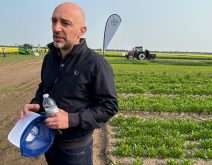RED DEER Ñ Horticulture is an international business at DentoomÕs Greenhouses in Red Deer.
Owned by John and Lori Bouw, the family run operation has a major storefront garden centre but its main business is selling cuttings and starting new plants for 800 other growers across Canada.
The business was established in 1954 by Harry Dentoom and purchased by the
Bouws in 1991. It has gone through four expansions with the latest completed this year.
The garden centre sells mostly annual plants: five million cuttings and seedlings were shipped to growers as far away as Ontario this year.
Read Also

VIDEO: Green Lightning and Nytro Ag win sustainability innovation award
Nytro Ag Corp and Green Lightning recieved an innovation award at Ag in Motion 2025 for the Green Lightning Nitrogen Machine, which converts atmospheric nitrogen into a plant-usable form.
Some plants are started from seed but many are grown from plant cuttings imported from Central America, Asia and Europe.
Thousands of annual plants are grown under 110,000 sq. feet of tempered glass using the latest computerized greenhouse technology to take advantage of solar energy and to reduce energy costs. The greenhouse covers 2.5 acres.
The busy season is between January and June when the operation is receiving and growing plant cuttings from Japan, Europe, Costa Rica, Kenya, Mexico and Israel.
About 6,000 cuttings arrive packed in a Styrofoam box. The cuttings are worth 10 to 12 cents each. They are shipped by a courier from the Calgary airport.
ÒIt is amazing how few problems we have in bringing the cuttings in. The main problems are between Calgary and here,Ó said John Bouw.
Many of the cuttings come from Costa Rica where more growers are relocating to save energy costs. Cuttings that are clipped on a Monday in Costa Rica arrive at the Calgary airport by Wednesday.
ÒWe are seeing a huge trend where more companies are moving to Central America to save on heat,Ó he said.
ÒThe quality of cuttings we get out of Central America is better than what we can grow here in the winter.Ó
In Canada, there are not enough hours of sunlight and the homegrown plants can be weak.
Cuttings start as a few leaves and short piece of stem taken from a mother plant. A mother plant can yield 150 cuttings. The new plants are rooted in a peat mixture and eventually move through various stages in the greenhouse.
Every plant has a specific growing time, which is entered in a computer so that the Bouws know when they are ready.
The greenhouse is kept sterile and is cleaned when the old crop is gone. All debris that could harbour viruses or other diseases is swept away. Everything is pressure washed and a special type of ammonia is sprayed to get rid of pests.
Entry to the operation is restricted and visitors during the growing season must wear latex gloves.
There are other challenges.
Energy costs increase every year.
The Bouws rely on natural gas because they have not found options such as burning coal or wood chips to be feasible for them.
The couple also saves money by collecting rainwater and condensation droplets from the building, which is sent to ponds for later use. Water collected from the roof is slightly acidic, which is not a bad thing since most plants prefer a low pH balance.
The local water supply is hard with high levels of calcium, magnesium and sodium and can corrode the water filtration system.
Other environmental problems include poplar fluff, grain dust and bird droppings, which can bring in unwelcome seeds through the drip irrigation system.
Wild plants can end up growing among the nursery stock.
ÒPoplar fluff has plugged up our filters. It causes us havoc,Ó Bouw said.
Finding competent staff is difficult.
In the last few years the Bouws have hired 24 Mexican women on temporary work permits. The Bouws are responsible for bringing them to Canada and must provide housing. The greenhousesÕ Canadian employees have studied Spanish to assist in communication.

















